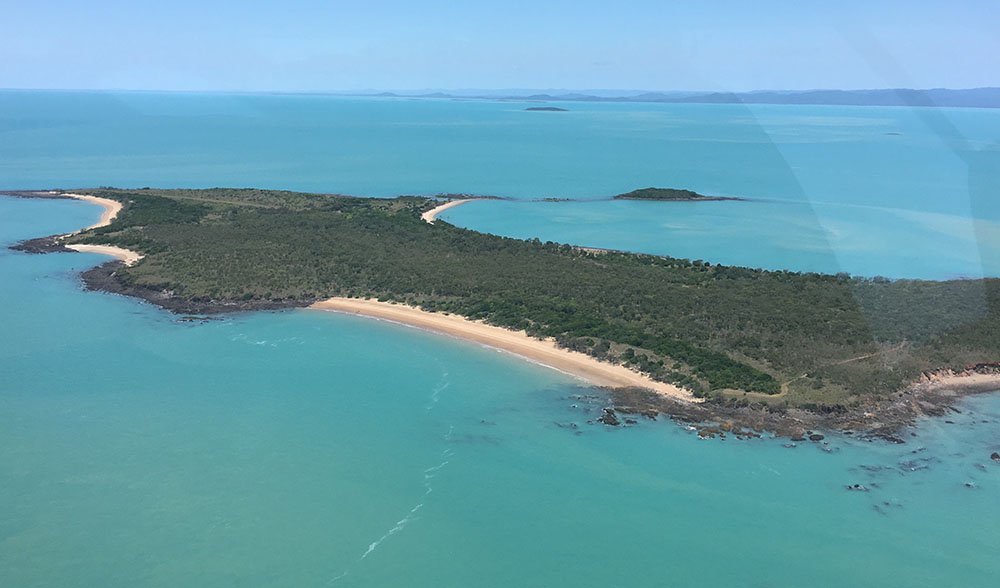Turtle nursery: satellite tracking flatbacks on human-free, predator-free island

JUST OFF THE coast of Mackay, Queensland, lies Avoid Island. It’s idyllic – there are no humans, no predators and no light pollution. And between October and January, its beaches become a rookery for flatback turtles, who have now started to arrive to lay some of the 7000 eggs that are buried here each breeding season.
This year for the first time, researchers will stay on the island for the full breeding season and will be attaching new satellite tracking devices to the flippers of some individuals to better understand where they go – and what they do – when they leave the beach.
The 83ha island was taken over by Queensland Trust for Nature (QTFN) in 2006 and for the past five years the turtles have been monitored for two weeks each breeding season by scientists from Griffith University.

Aerial view of 83ha Avoid Island, just off the coast of Mackay, QLD. (Image courtesy QTFN)
“We’ve only been able to get a snapshot of what turtles are nesting in that period between October until January,” said Felicity Shapland, QTFN environmental officer. “We’ll now be able to get a much better handle on the baseline of the population using Avoid Island as a rookery.”
Each night, researchers and volunteers head out to the three beaches that the turtles most commonly nest at and, when they come in to lay, they are microchipped – titanium tags are placed on their flippers as a unique identifier, and now satellite tracking devices will also be attached to some individuals to provide vital information about where this elusive species go after they leave the island.
The five-year data collected by Griffith University shows the hatchlings have a good success rate of 80-90 per cent. “Not every egg laid will hatch, there are king tides and climate change means they can essentially cook in high temperatures,” said Felicity. “Nests can be predated and of course there will be natural deformities in some eggs.”

A nesting female flatback turtle encountered by the research team on Avoid Island. (Image courtesy QTFN)
The standard estimate for the species is that one in 1000 hatchlings will make it to adulthood, so even a 100 per cent success rate means there will be just seven adults for the Avoid Island turtles produced in one breeding season.
“They’re a fragile species that are impacted by humans in a big way,” said Felicity. “They don’t reach sexual maturity until they’re 30, so there’s that lag to get data on these hatchlings – we can’t track them with the technology that we have, as it’s too expensive to attach satellites to them and they are too small for tags.”
It is hoped the data will provide insights into the biggest threats the turtles face – from pollution to boat strikes – to help plan conservation efforts. Adding to the puzzle is the difficulty of collecting information about males – they are a cryptic species, spending all of their lives at sea.
QTFN’s Hannah Watson measuring a turtle’s shell. The average size of flatback turtle shells at Avoid Island is 93.5cm, this particular turtle measured at just over 90cm. The condition of the shell was good but there was a chunk out of her shell which is likely to be the result of a shark bite or boat strike. (Video courtesy QTFN)
On a recent trip to the island, one turtle was found to have been originally tagged on Wild Duck Island in 1988 – and last seen by QTFN researchers in 2012 – putting her age between 50 and 60 years old.
Nerida Bradley, QTFN general manager, said a full ecological survey of Avoid Island will also be conducted to learn more about the other wildlife that lives there.
“Avoid Island is a great opportunity for people to come and have a look and better understand the threats and pressures that marine environments are under,” she said.
READ MORE:
- Flatback turtle migration route mapped
- Tracking turtle nests at Eco Beach, WA
- Turtles choose their egg-laying date




